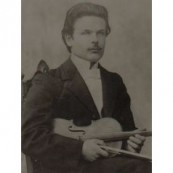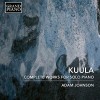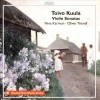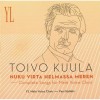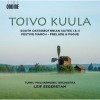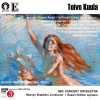Composers
Toivo Timoteus Kuula (7 July 1883 – 18 May 1918) was a Finnish conductor and a composer. He was born in the Vehkakoski village of the Alavus town and registered as a native in the city of Vaasa (then Nikolainkaupunki), when Finland still was a Grand Duchy under Russian rule. He is known as a colorful and passionate portrayer of Finnish nature and people.
In 1909, Kuula became Jean Sibelius's first composition student. He is best remembered for his large output of melodic choir and vocal works. His instrumental works include two Ostrobothnian Suites for orchestra, a violin sonata, a piano trio, and an unfinished Symphony. Kuula's major choral work is often considered the cantata Stabat Mater, which was completed in spring 1915 (original version, later lost) but revised, beginning 1917 and unfinished at the time of his death. He also wrote a few dozen highly artistic piano works.
A Swedish critic once said that Kuula's music reaches parts of the human spirit where one is forced to deep examination of one's self.[citation needed]
Kuula was known to be a fierce Fennoman. He died in the provincial hospital in Viipuri in 1918 after being mortally wounded 18 days earlier on Walpurgis Night by a bullet fired by a Jäger. The bullet was fired as a result of a quarrel that happened at the Hotel Seurahuone in conjunction with the first victory celebration of the White victory in the Civil War of Finland. Kuula is buried in Hietaniemi cemetery, Helsinki.
Recently Added
| Country: | Finland |
| Period: | Romantique |
Biography
Toivo Timoteus Kuula (7 July 1883 – 18 May 1918) was a Finnish conductor and a composer. He was born in the Vehkakoski village of the Alavus town and registered as a native in the city of Vaasa (then Nikolainkaupunki), when Finland still was a Grand Duchy under Russian rule. He is known as a colorful and passionate portrayer of Finnish nature and people.
In 1909, Kuula became Jean Sibelius's first composition student. He is best remembered for his large output of melodic choir and vocal works. His instrumental works include two Ostrobothnian Suites for orchestra, a violin sonata, a piano trio, and an unfinished Symphony. Kuula's major choral work is often considered the cantata Stabat Mater, which was completed in spring 1915 (original version, later lost) but revised, beginning 1917 and unfinished at the time of his death. He also wrote a few dozen highly artistic piano works.
A Swedish critic once said that Kuula's music reaches parts of the human spirit where one is forced to deep examination of one's self.[citation needed]
Kuula was known to be a fierce Fennoman. He died in the provincial hospital in Viipuri in 1918 after being mortally wounded 18 days earlier on Walpurgis Night by a bullet fired by a Jäger. The bullet was fired as a result of a quarrel that happened at the Hotel Seurahuone in conjunction with the first victory celebration of the White victory in the Civil War of Finland. Kuula is buried in Hietaniemi cemetery, Helsinki.
